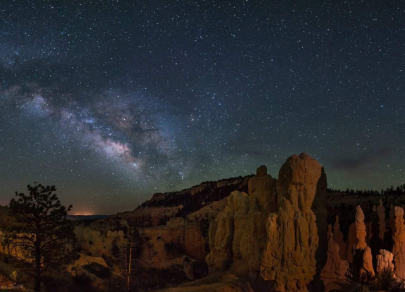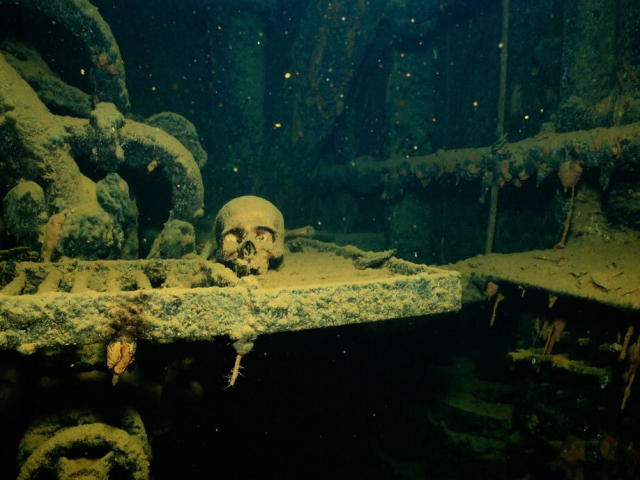
Top 5 locations for stargazing
Astrotourism is becoming more popular every year. People are willing to travel thousands of kilometers to admire the stars. But which places on Earth are considered the best for this? Let's find out now!




Underwater Yonaguni Monument, Japan
An amazing submerged rock formation located at the southernmost point of the Japanese island was discovered by divers in 1986.
According to scientists, the Yonaguni complex was built by representatives of an ancient highly developed civilization no less than 10 thousand years ago. In favor of this version, there are terraces, similar to the staircases, with flat, straight sides and sharp corners reminiscent of something like the stepped pyramids of the Ancient Sumer.
In addition, this is a good place to observe the hammerhead sharks. There are a lot of them here in winter.

Underwater Museum Sculptures, Cancun, Mexico
The Mexican city of Cancun has recently become one of the world's major centers for divers.
The idea to divert the attention of tourists from coral reefs belongs to sculptor and diver Jason deCaires Taylor who now plans to create a huge underwater museum in the Caribbean Sea with 27,000 exhibits named Silent Evolution. It must remind people how closely they are connected with nature and convey the physical and social evolution of man from antiquity to modern times.

Underwater Museum Sculptures, Cancun, Mexico
The museum exposition includes more than 400 sculptures united in groups. All of them have a steel frame inside and stand on the bottom of the sea on impressive pedestals. The Taylor's Underwater Sculpture Museum, which from afar can be taken for a cemetery of a civilization that has gone under water, is planned to be completed by 2025.
Interest in this place is fueled by the fact that most of the sculptures are created in the image and likeness of the descendants of the Maya, the ancient Indian tribes that once inhabited the Yucatan peninsula.

Devil's Cave System in Ginnie Springs, Florida, the USA
Crystal clear water, comfortable temperature and incredible landscapes of underwater caves in the Ginnie Springs area make them quite popular among divers. And if you can dive without a special tight suit, then you should not forget about the safety rules: these caves are known for their strong undercurrents and whirlpools, for which they are often called "devilish".

Sweepstakes Sunken schooner, Lake Huron, Canada
You do not need to be a diver to see a huge ship in the clear waters of the Canadian Lake Huron stranded in the distant 1885.
Despite the fact that the schooner decently suffered during the storm, its remains are well preserved and now delight visitors of the Fathom Five National Marine Park.
To prevent the divers from penetrating the ship and further destroying it, metal cables were pulled between its fragments and the wire fence was put.

Cenotes Dos Ojos, Tulum, Mexico
The collapse of the limestone cave's roof resulted in the creation of several natural cenotes fascinating with their beauty.
Cenotes, discovered about 30 years ago, look like two big eyes and represent a wide network of surface and underwater caves, the purest waters of which are literally pierced by the golden rays of the sun which creates a magnificent play of light and colors under the water.
Swimming and snorkeling (scuba diving with a tube and a mask) in the cenote will leave indelible impressions. In the early 2000s, in the "chambers" with stalactites and stalagmites, the IMAX company filmed several movies.

Christ of the Abyss, San Fruttuoso, Italy
You can include a statue, located in the Italian bay of San Fruttuoso at a depth of 17 m, to the list of the most famous sculptural images of Christ. Thousands of divers from all over the world dream to visit it.
Christ of the Abyss was installed in 1954 by sculptor Guido Galletti in memory of the Italian diver, drowned in the bay, who created an aqualung, Dario Gonzatti. The face and hands of Christ are raised to heaven symbolizing peace and good.
Periodically, the figure of the Son of God, cast in commemorative medals, ships and bells, is taken from the sea for cleaning and reconstruction. Copies and versions of the monument can be found in the area of the Dry Rocks underwater coral reef (Florida, the USA), as well as in the waters of the Maltese archipelago.

Great Blue Hole, Belize
The Belize barrier reef has gained worldwide fame thanks to the huge round karst funnel located on its territory. Because of its exceptional dimensions (300 m in diameter and 120 m in depth), the Great Blue Hole of Belize is protected by UNESCO.
It was formed when, under the influence of rising sea level, the roof of the underwater cave collapsed. After the research conducted here by the team of Jacques-Yves Cousteau, the karst pit entered the list of 10 best places for diving.

Green Lake, Tragoess, Austria
The famous lake in the Austrian village of Tragoess becomes one of the most interesting wonders of nature from April to October when during the rapid thawing of snow the space in the gorge is filled with crystal clear water which becomes emerald green.
Guests of the underwater park can relax on the benches amidst the swaying trees, walk along the green lawns, admire the bright flower beds and the flocks of fish swimming by.

Silfra Fissure, Island
The underwater gorge of Silfra, or the "Silver Lady", located in the Thingvellir Icelandic national park, earned a huge popularity among divers from all over the world.
The immersion in the underwater world of the lava gorge hidden in the depths of the largest lake in Iceland will not leave anyone indifferent: the visibility in clear water exceeds 100 m, and the flora and fauna are so rich that they made this site a UNESCO World Heritage Site.

Chuuk Lagoon, Micronesia
Who would have thought that under the crystal clear tropical waters off the coast of Micronesia one of the largest cemeteries of military equipment in the world is located, the infamous Chuuk Lagoon.
In 1944, in this heavenly place, as a result of a massive air raid of American troops, dozens of ships and hundreds of aircraft were sunk at the strategic center of the Japanese navy. A carefully planned attack led to an unexpectedly quick and easy victory. After a quarter of a century, French military researcher Jacques-Yves Cousteau discovered this wiped out Japanese military base, and since then the natural lagoon, like a magnet, attracts all who can not live without extreme sensations.

Chuuk Lagoon, Micronesia
Strong currents of the open ocean almost did not touch the terrible picture, imbued with such atmosphere of pain and despair that it will be erased only after centuries. Soldiers had no chances to survive: the crews of many vessels drowned. The dying people could only watch with horror how the water one by one filling the compartments displacing the last breaths of air.
Here, among human remains, unexploded ordnance, army equipment, boxes of food, divers continue to die, so it is forbidden to dive alone or disappear from the sight of other divers.

Underwater Post office, Vanuatu
Vanuatu, one of the poorest countries on the planet, has been actively developing tourism in recent years.
So, on the island, there is a real post office working for 15 years already, the underwater office of which is located 30 meters from the shore at a depth of three meters.
You can buy a thematic plastic postcard in a small kiosk, then you should put it in a small red box. The joy of receiving such a postcard is not inferior to the pleasure of sending it.

Astrotourism is becoming more popular every year. People are willing to travel thousands of kilometers to admire the stars. But which places on Earth are considered the best for this? Let's find out now!